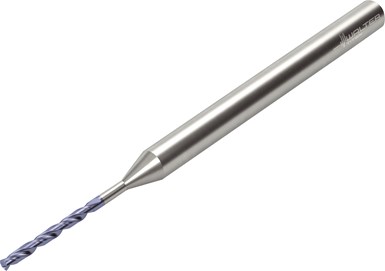Walter Micro Drill Has Internal, External Coolant Capabilities
Appears in Print as: 'Micro Drill Has Internal, External Coolant Capabilities'
Walter USA’s Supreme DB133 solid carbide micro drill delivers high precision and productivity.
#micromachining
Edited by Angela Osborne

Walter USA’s DB133 solid carbide micro drill offers internal and external coolant capabilities for enabling precise, reliable working processes and achieving significantly longer tool life in steel, cast iron and nonferrous materials (ISO P, K and N workpiece groups), according to the company.
The use of Walter grades WJ30EL and WJ30ER is said to increase the drills’ wear resistance. The company says that the drill’s geometry increases process reliability and optimizes dimensions to allow for maximum stability, even with the smallest drills. The uniform finish on the drill cutting edges and tight tolerances ensure an excellent surface finish of the drilled holes.
With its flute geometry, the chips (swarf) are effectively evacuated. This means that hole depths of up to 12 × Dc can be achieved. Oil or emulsion can both be used as a coolant with these drills. For deeper holes beyond 8 × Dc, Walter has a corresponding line of DB131 micro drills.
The DB133 drill has a 140-degree point geometry and is available in a diameter range from 1/32-5/64" and 0.5 to 2.95 mm. Length-to-diameter ratios of 5, 8 and 12 × Dc are standard. The drill design is well-suited for general manufacturing, mold and die making, medical, energy and automotive industries and any other areas where small-diameter, deep holes are required.
RELATED CONTENT
-
Thread Whirling Basics
The rapidly increasing demand for high-value threaded parts with exceptionally high length-to-diameter ratios has created a lot of interest in thread whirling technology among American shops and manufacturers.
-
Skiving Long, Slender Parts with Tight Tolerances
Here's a look at one of the oldest and most efficient methods of screw machine production for parts that are long and slender, with close-diameter tolerances and finishes, or parts that require truly spherical radii.
-
5 Process Security Tips for Parting Off
Here are five rules of thumb from Scott Lewis, a product and application specialist at Sandvik Coromant, to optimize the parting off process, and as a result, maximize tool and insert life.



